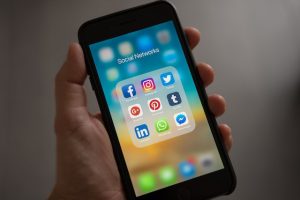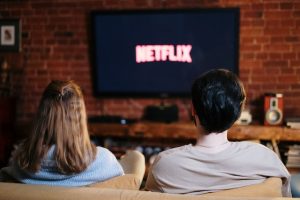Chapter 10: Media, Technology, and Communication
Learning Objectives
- Define mass media and differentiate between traditional and new media.
- Identify key functions of the mass media.
- Discuss media effects theories, including bullet theory, agenda-setting theory, and uses and gratifications theory.
- Explore ethical issues of control, representation, and surveillance in the mass media.
- Employ media literacy skills to evaluate media messages.

Throughout history, evolving media technologies have changed the ways we relate and communicate. In 2007, for example, a joint venture between the 24-hour news network CNN and the video-sharing site YouTube allowed voters to pose questions directly to presidential candidates in two televised debates. Voters could record their questions and upload them to YouTube, and a selection of these videos were then chosen by the debate moderators and played directly to the presidential candidates. This new format opened up the presidential debates to a wider array of people, allowing for greater voter participation than had been possible in the past, where questions were posed solely by journalists or a few carefully chosen audience members.
In today’s world of smartphones and streaming, our expectations of our leaders, celebrities, teachers, and even ourselves are changing in even more drastic ways. This chapter examines the ever-changing media and technological landscapes and their effects on communication. First, we will explore the functions and effects of mass communication. Second, we will turn to ethics and media literacy.
10.1 Mass Media and Communication
To begin, it is important to define and distinguish different types of media. Often, this chapter will reference the broad category of mass media, defined as various channels of communication that are designed to reach a wide audience. Many textbooks also make a distinction between “old” or “traditional” media and “new” media. Traditional media consists of channels that have been around for decades, including print, radio, and television/film. Traditional media tends to use one-way and delayed communication. For example, we don’t have a way to influence an episode of The Last of Us as we watch it. We could send messages to the show’s producers and hope our feedback is received, or we could yell at the television, but neither is likely to influence the people responsible for sending the message. In contrast, new media consists of interactive, immediate, and portable channels of communication made possible through the technological advances of recent decades. Examples include social media, text messages, and emails. Consider how new media, as opposed to traditional media, allows us to communicate directly and immediately with different individuals and organizations using messages, comments, likes and dislikes, subscriptions, follows, and other interactions.
So how does mass mediated communication function differently than interpersonal communication? Do we have relationships with media like we have relationships with people? How does mediated communication influence society? To answer these questions, we can look at some of the functions and effects of mass communication.
Functions of Mass Communication
Mass mediated communication fulfills several basic roles in our society. One obvious role is entertainment. Media can act as a springboard for our imaginations, a source of fantasy, and an outlet for escapism. In the 19th century, Victorian readers disillusioned by the grimness of the Industrial Revolution found themselves drawn into fantastic worlds of fairies and other fictitious beings. In the 21st century, American television viewers can escape to galaxies far, far away in the Star Wars universe or to a pineapple under the sea in SpongeBob SquarePants. Through bringing us stories of all kinds, the mass media has the power to take us away from ourselves.

The mass media can also provide information and education. Information can come in many forms, and it may sometimes be difficult to separate from entertainment. Today, news websites, papers, magazines, and television shows make available stories from across the globe, allowing readers or viewers in London to access voices and videos from Baghdad, Tokyo, or Buenos Aires. Websites like Wikipedia have articles on topics from presidential nicknames to child prodigies to tongue twisters in various languages. The Massachusetts Institute of Technology (MIT) has posted free lecture notes, exams, and audio and video recordings of classes on its OpenCourseWare website, allowing anyone with an Internet connection access to world-class professors.
Another important function of the mass media is to serve as a watchdog, or an entity that monitors and investigates government, business, and other institutions. Upton Sinclair’s 1906 novel The Jungle exposed the miserable conditions in the turn-of-the-century meatpacking industry; and in the early 1970s, Washington Post reporters Bob Woodward and Carl Bernstein uncovered evidence of the Watergate break-in and subsequent cover-up, which eventually led to the resignation of President Richard Nixon. But purveyors of mass media may also be beholden to particular agendas because of political slant, advertising funds, or ideological bias, thus constraining their ability to act as a watchdog.
As we consider the functions of the mass media, it’s important to remember that not all media are created equal. While some forms of mass communication are better suited to entertainment, others make more sense as a venue for spreading information. For example, books are durable and able to contain a lot of information, but are relatively slow and expensive to produce. In contrast, websites are quick and easy to update, making them a better medium for the quick turnover of daily news. Podcasts and radio programs are easily accessible while driving and doing other tasks, but television provides vastly more visual information. Media theorist Marshall McLuhan (1965) took these ideas one step further, famously coining the phrase “the medium is the message.” By this, McLuhan meant that every medium delivers information in a different way and that content is fundamentally shaped by the medium of transmission. For instance, although television news has the advantage of offering video and live coverage, making a story come alive more vividly, it is also a faster-paced medium. That means more stories get covered in less depth. A story told on television will probably be flashier, less in-depth, and with less context than the same story covered in a monthly magazine; therefore, people who get the majority of their news from television may have a particular view of the world shaped not by the content of what they watch but its medium.
Effects of Mass Communication

Media effects are the intended or unintended consequences of what the mass media does (McQuail, 2010). Many of the key theories in mass communication rest on the assumption that the media has effects on audience members. The degree and type of effect varies depending on the theory. In general, we underestimate the effect that the media has on us, as we tend to think that media messages affect others more than us. The third-party effect describes the phenomenon of people thinking they are more immune to media influence than others. If this were true, though, would advertisers and public relations professionals spend billions of dollars a year carefully crafting messages aimed at influencing viewers?
There are certain media effects that are fairly obvious and most of us would agree are common (even for ourselves). For example, we change our clothes and our plans because we watch the forecast on the local news, look up information about a band and sample their music after we see them perform on a television show, or stop eating melons after we read about a salmonella outbreak. Other effects are more difficult to study and more difficult for people to accept because they are long term and/or more personal. For example, media may influence our personal sense of style, views on sex, perceptions of other races, or values just as our own free will, parents, or friends do. It is difficult, however, to determine in any specific case how much influence the media has on a belief or behavior in proportion to other factors that influence us. Media messages may also affect viewers in ways not intended by the creators of the message. Three theories focused on media effects include bullet theory, agenda-setting theory, and uses and gratifications theory.
Bullet Theory
An early approach to studying media effects was called the hypodermic needle approach, or bullet theory and suggested that the media constructed a message with a particular meaning that was “injected” or “shot” into individuals within the mass audience. It was assumed that the effects were common to each individual and that the meaning wasn’t altered as it was transferred. Through experiments and surveys, researchers hoped to map the patterns within the human brain so they could connect certain stimuli to certain behaviors. For example, researchers might try to prove that a message announcing that a product is on sale at a reduced price will lead people to buy a product they may not otherwise want or need. As researchers investigated bullet theory over the years, they began to find flaws within this line of thinking. New theories emerged that didn’t claim such a direct connection between the intent of a message and any single reaction on the part of receivers. Instead, these new theories claimed that meaning could be partially transferred, that patterns may become less predictable as people are exposed to a particular stimulus more often, and that interference at any point in the transmission could change the reaction.
Agenda-Setting Theory

In contrast to the extreme views of bullet theory, the agenda-setting theory of media stated that mass media determine the issues that concern the public, rather than the public’s views. Under this theory, the issues that receive the most attention from media become the issues that the public discusses, debates, and demands action on. This means that the media is determining what issues and stories the public thinks about. Therefore, when the media fails to address a particular issue, it becomes marginalized in the minds of the public (Hanson, 2009).
When critics claim that a particular media outlet has an agenda, they are drawing on this theory. Agendas can range from a perceived political bias in the news media to the propagation of certain worldviews in films. For example, the agenda-setting theory explains such phenomena as the rise of public opinion against smoking. Before the mass media began taking an anti-smoking stance, smoking was considered a personal health issue. By promoting anti-smoking sentiments through advertisements, public relations campaigns, and a variety of media outlets, the mass media moved smoking into the public arena, making it a public health issue rather than a personal health issue (Dearing & Rogers, 1996). More recently, coverage of mass shootings has been prominent in the news. However, when news coverage wanes, so does the general public’s interest.
Uses and Gratifications Theory
Practitioners of the uses and gratifications theory study the ways the public consumes media. This theory states that consumers use the media to satisfy specific needs or desires. For example, you may enjoy watching a reality show while simultaneously chatting about it on social media with your friends. Many people use the internet to seek out entertainment, to find information, to communicate with like-minded individuals, or to pursue self-expression. Each of these uses gratifies a particular need, and the needs determine the way in which media is used. By examining factors of different groups’ media choices, researchers can determine the motivations behind media use (Papacharissi, 2009).

Researchers have identified a number of common motives for media consumption. These include relaxation, social interaction, entertainment, arousal, escape, and a host of interpersonal and social needs. By examining the motives behind the consumption of a particular form of media, researchers can better understand both the reasons for that medium’s popularity and the roles that the medium fills in society. A study of the motives behind a given user’s interaction with Snapchat, for example, could explain the role Snapchat takes in society and the reasons for its appeal.
10.2 Ethics and Media Literacy
Given the potential for mass communication messages to reach thousands to millions of people, the potential for positive or negative consequences of those messages exceeds those of interpersonal, small group, organizational or even public communication messages. Because of this, questions of ethics have to be closely considered when discussing mass communication and the media. In this section, we will discuss ethical issues in mass communication and how media literacy can help combat those issues.
Ethics
Ethical issues exist at all levels of media usage. An individual may unethically engage in cyber-bullying or misrepresent themselves on a social media profile. A tabloid news organization may spread false information online. A government may put out propaganda or spy on its citizens. Three broad categories of ethical concerns include control, representation, and surveillance.
Media Control and Ownership
Media interests and ownership have become concentrated in recent decades through mergers and consolidations. Companies that you’re familiar with now but may not have known were once separate entities include Warner Bros. Discovery (which includes Warner Bros., HBO, Discovery, CNN, Turner Broadcasting, and more) and the Walt Disney Company (which includes Disney, ABC, ESPN, FX, and National Geographic, among others). The mergers of these media companies were meant to provide a synergy that could lower costs and produce higher profits. Critics decry consolidated media ownership as unfair, as smaller or independent companies are unable to compete with in time, resources, or money.

Consolidated media ownership has also led to a decrease in localism in terms of local news and local reporters, radio DJs, and editors (Austin, 2011). Since business is handled from a central hub that might be hundreds or thousands of miles away from a market the media outlet serves, many of the media jobs that used to exist in a city or region have disappeared.
Issues of ownership and control are present in new media as they are in traditional mass media. Although people may think they are multitasking and accessing different media outlets, they may not be. To help keep users within their domain, some large new media platforms like Facebook create expansive environments that include news, social media connections, advertising, and entertainment, which allow users to click around and feel like they are moving freely even though they are not leaving the general owner’s space.
Media and Representation
Another area of concern for those who study mass media is the representation of diversity (or lack thereof) in media messages. The U.S. population is becoming increasingly diverse. Yet in television and streaming programs, major publications, and other forms of mass media and entertainment, minorities are often either absent or presented as heavily stereotyped, two-dimensional characters. The stereotyping of women, LGBTQ individuals, and individuals with disabilities in mass media has also been a source of concern. Whether we want them to be or not, the people we see featured in media messages serve as role models for many that view them. These people help set the tone for standards of behavior, beauty, and intelligence, among other things. Social learning theory claims that media portrayals influence the development of schemata or scripts, especially as children, about different groups of people (Signorielli, 2009). For example, a person who grows up in a relatively homogenous white, middle-class environment can develop schemata about African Americans and Latina/os based on how they are depicted in media messages.
A similar lack of diversity has been found in new media. In a study of gender representation in online news sources, the Global Media Monitoring Project found after analyzing news stories on 76 websites in 16 countries that only 36 percent of the stories were reported by women, and women were the focus of only 23 percent of all the stories written (Gallagher, 2010). Another look at popular, blog-style news sites such as The Huffington Post, The Daily Beast, Slate, and Salon found that representations of minorities conformed to stereotypes. For example, African Americans were featured primarily in stories about athletics, Latino/as appeared in stories about immigration, and Native and Asian Americans were absent (Jackson, 2012).
Media Filtering and Surveillance
Research shows that internet content filtering is increasing as new technologies allow governments and other entities to effectively target and block internet users from accessing undesirable information. For example, in 2002 only two countries, China and Saudi Arabia, were known to actively filter internet content within their borders. Presently, many more countries, including the United States, engage in such content filtering. While internet service providers can block content, other institutions can also censor content using software or other technical means. This type of blocking may be carried out to meet the objectives or values of a particular institution—for example, to block sexually explicit information from school computers. Finally, censorship can occur at the individual computer level. In such cases, parents may want to control the information available to their children.

Typically, blocked content includes pornography or other materials deemed sexually explicit, information deemed harmful to national security or public safety (e.g., bomb-making information), and information that challenges a government or regime’s power (Deibert, 2008). In 2009, Bahrain was reported to make the most substantial increase in filtering of any country, as it limited many social, religious, political, and human rights sites (Faris & Zittrain, 2009). In terms of politics and human rights blocking, China blocked access to Twitter in the lead-up to the twenty-year anniversary of the Tiananmen Square protests. Religiously offensive material can also be blocked as evidenced by Pakistan’s practice of blocking information that is offensive to Islam.
Electronic espionage has been around since communication technologies like the telegraph, sound-recording devices, and radios were invented. Many countries, including the United States, have long had limitations on and protections against the use of electronic surveillance on US citizens, but these restrictions have been lessened and reinterpreted over time. With new media come new opportunities for electronic surveillance. Internet based “wiretaps”—the unauthorized and unknown monitoring or collection of e-mail, web-surfing data, or even keyboard strokes—are now employed, and that information may be shared with law enforcement or intelligence agencies (Deibert, 2008).
Such surveillance techniques are not just used by government or intelligence agencies; they are also used by companies. You’re likely used to clicking “accept” on lengthy terms of use agreements and privacy policies that pop up when using an app or website. These agreements often allow companies to track our usage of their program or product. While this tracking often improves a product’s functionality or connects us with services that the program deems useful or relevant to us, it also raises ethical concerns.
Media Literacy
Media literacy involves our ability to critique and analyze the potential impact of the media. The word literacy refers to our ability to read and comprehend written language, but just as we need literacy to be able to read, write, and function in our society, we also need to be able to read media messages. Media literacy isn’t meant to censor or blame the media, nor does it advocate for us to limit or change our engagement with the media in any particular way. Instead, media literacy ties in with critical thinking and listening, which we have learned about throughout this book already. Media literacy skills are important because media outlets are culture makers, meaning they reflect much of current society but also reshape and influence sociocultural reality and real-life practices. Some may mistakenly believe that frequent exposure to media or that growing up in a media-saturated environment leads to media literacy. Knowing how to use technology to find and use media is different from knowing how to analyze it. Like other critical thinking skills, media literacy doesn’t just develop; it must be taught, learned, practiced, and reflected on.

Media literacy skills teach us to analyze the media and to realize the following:
- All media messages are constructed (even “objective” news stories are filmed, edited, and introduced in ways that frame and influence their meaning).
- Media structures and policies affect message construction (which means we need to also learn about how media ownership and distribution function in our society).
- Each medium has different characteristics and affects messages differently (e.g., a video on TikTok will likely be less complete than a story presented on a blog focused on that topic).
- Media messages are constructed for particular purposes (many messages are constructed to gain profit or power, some messages promote change, and some try to maintain the status quo).
- All media messages are embedded with values and beliefs (the myth of objectivity helps mask the underlying bias or misrepresentation in some messages).
- Media messages influence our beliefs, attitudes, values, and behaviors, including how we perceive and interact with others and how we participate in larger society.
We learn much through the media that we do not have direct experience with, and communication and media scholars theorize that we tend to believe media portrayals are accurate representations of life. However, the media represents race, gender, sexuality, ability, and other cultural identities in biased and stereotypical ways that often favor dominant identities (Allen, 2011). Since the media influences our beliefs, attitudes, and expectations about difference, it is important to be able to critically evaluate the mediated messages that we receive. The goal of media literacy is not to teach you what to think but to teach you how you can engage with, interpret, and evaluate media in a more informed manner. Media literacy is also reflective in that we are asked to be accountable for those choices we make in regards to media by reflecting on and being prepared to articulate how those choices fit in with our own belief and value systems.
There are some standard questions that you can ask yourself to help you get started in your media criticism and analysis. There are no “true” or “right/wrong” answers to many of the questions we ask during the critical thinking process. Engaging in media literacy is more about expanding our understanding and perspective rather than arriving at definitive answers. The following questions will help you hone your media literacy skills (Allen, 2011):
- Who created this message? What did they hope to accomplish? What are their primary belief systems?
- What is my interpretation of this message? How and why might different people understand this message differently than me? What can I learn about myself based on my interpretation and how it may differ from others’?
- What lifestyles, values, and points of view are represented or omitted in this message? What does this tell me about how other people live and believe? Does this message leave anything or anyone out?
- Why was this message sent? Who sent it? Is it trying to tell me something? To sell me something?
After asking these questions, media literate people should be able to use well-reasoned arguments and evidence (not just opinion) to support their evaluations. People with media literacy skills also know that their evaluations may not be definitive. Although this may seem like a place of uncertainty, media literate people actually have more control over how they interact with media messages, which allows them to use media to their advantage, whether that is to become better informed or to just enjoy their media experience.
Key Concepts: Media Literacy
Media literacy skills allow us to critique and analyze the potential effects of media. Media literate people ask critical questions about all the media messages they receive, not just the ones with which they disagree. Doing so leads people to be more accountable for their media choices and to have more control over the role that media plays in their lives.
Discussion Questions:
- Think about a media channel that you use often (e.g., a streaming platform, television channel, or social media site). Look up who owns that channel. How do you think the issues of ownership and control influence how that channel is run?
- Think about a recent film or TV show that you’ve watched. Is the show’s cast of characters diverse in terms of gender, race, and other cultural factors? Are any characters portrayed in stereotypical or narrow ways? Why or why not? How much do you think diversity matters in the media?
- Some critics believe that efforts to be more media literate make consuming media less enjoyable. What are some strategies we can use to be ethical, critical consumers of media while still allowing ourselves to “escape” and be entertained?
References
Allen, B. J. (2011). Difference matters: Communicating social identity (2nd ed.) Waveland.
Austin, C. (2011). Overwhelmed by big consolidation: Bringing back regulation to increase diversity in programming that serves minority audiences. Federal Communications Law Journal, 63(3), 734-764. Retrieved July 14, 2023, from https://www.repository.law.indiana.edu/fclj/vol63/iss3/7
Dearing, J., & Rogers, E. (1996). Agenda-setting. Sage.
Deibert, R. J. (2008). Black code redux: Censorship, surveillance, and the militarization of cyberspace. In M. Boler (Ed.), Digital media and democracy: Tactics in hard times (pp. 137–164). MIT Press.
Faris, R., & Zittrain, J. (2009). Web tactics. Index on Censorship, 38(4), 90–96. https://doi.org/10.1080/03064220903467208
Gallagher, M. (2010). Who makes the news? Global Media Monitoring Project. Retrieved July 14, 2023, from https://gsdrc.org/document-library/who-makes-the-news-global-media-monitoring-project-2010/
Hanson, R. (2009). Mass communication: Living in a media world. CQ Press.
Jackson, J. (2012, June 1). New media; but familiar lack of diversity. Fairness & Accuracy in Reporting. https://fair.org/extra/new-media8212but-familiar-lack-of-diversity/
McLuhan, M. (1964). Understanding media: The extensions of man. McGraw-Hill.
McQuail, D. (2010). McQuail’s mass communication theory (6th ed.). Sage.
Papacharissi, Z. (2009). Uses and gratifications. In D. Stacks & M. Salwen (Eds.), An integrated approach to communication theory and research (pp. 139–154). Routledge.
Signorielli, N. (2009). Minorities representation in prime time: 2000–2008. Communication Research Reports, 26(4), 323–336. https://doi.org/10.1080/08824090903293619
Credits
Chapter 10 was adapted, remixed, and curated from Chapters 15 and 16 of Communication in the Real World: An Introduction to Communication Studies, a work produced and distributed under a CC BY-NC-SA license in 2013 by a publisher who has requested that they and the original author not receive attribution. The University of Minnesota Libraries Publishing edition was published in 2016 through the eLearning Support Initiative.
Chapter 10 also contains material adapted, remixed, and curated from Chapters 1, 2, and 14 of Understanding Media and Culture: An Introduction to Mass Communication, a work produced and distributed under a CC BY-NC-SA license in 2010 by a publisher who has requested that they and the original author not receive attribution. The University of Minnesota Libraries Publishing edition was published in 2016 through the eLearning Support Initiative.
